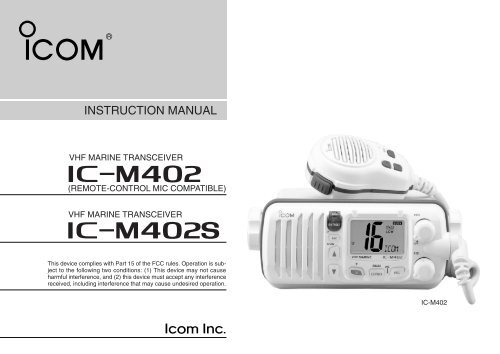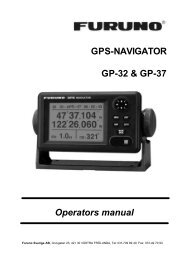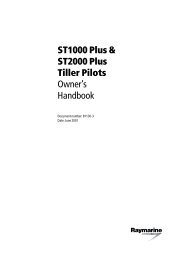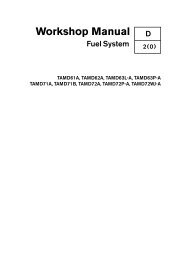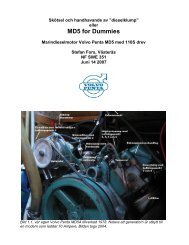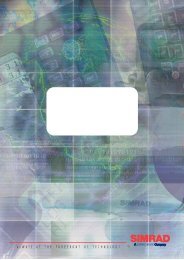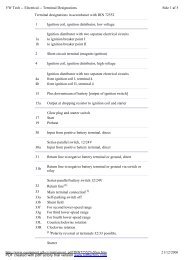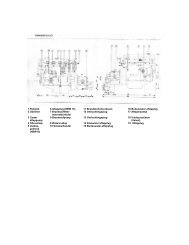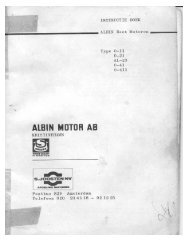IC-M402 - ICOM Canada
IC-M402 - ICOM Canada
IC-M402 - ICOM Canada
- No tags were found...
You also want an ePaper? Increase the reach of your titles
YUMPU automatically turns print PDFs into web optimized ePapers that Google loves.
INSTRUCTION MANUALVHF MARINE TRANSCEIVERi<strong>M402</strong>(REMOTE-CONTROL M<strong>IC</strong> COMPATIBLE)VHF MARINE TRANSCEIVERi<strong>M402</strong>SThis device complies with Part 15 of the FCC rules. Operation is subjectto the following two conditions: (1) This device may not causeharmful interference, and (2) this device must accept any interferencereceived, including interference that may cause undesired operation.<strong>IC</strong>-<strong>M402</strong>
IMPORTANTREAD ALL INSTRUCTIONS carefully and completelybefore using the transceiver.SAVE THIS INSTRUCTION MANUAL— This instructionmanual contains important operating instructions forthe <strong>IC</strong>-<strong>M402</strong>/<strong>M402</strong>S.EXPL<strong>IC</strong>IT DEFINITIONSWORDR WARNINGCAUTIONNOTEDEFINITIONPersonal injury, fire hazard or electricshock may occur.Equipment damage may occur.If disregarded, inconvenience only. No riskof personal injury, fire or electric shock.IN CASE OF EMERGENCYIf your vessel requires assistance, contact other vessels andthe Coast Guard by sending a distress call on Ch 16.USING CHANNEL 16DISTRESS CALL PROCEDURE1. “MAYDAY MAYDAY MAYDAY.”2. “THIS IS ...............” (name of vessel)3. Your call sign or other indication of the vessel (AND 9-digit DSC ID if you have one).4. “LOCATED AT ...............” (your position)5. The nature of the distress and assistance required.6. Any other information which might facilitate the rescue.Or, transmit your distress call using digital selective calling onCh 70.USING DIGITAL SELECTIVE CALLING (Ch 70)DISTRESS CALL PROCEDURE1. While lifting up the switch cover, push and hold[DISTRESS] for 5 sec. until you hear 5 short beepschange to one long beep.2. Wait for an acknowledgment from a coast station.•Channel 16 is automatically selected.3. Push and hold [PTT], then transmit the appropriateinformation as at left.ii
CAUTIONSRWARNING! NEVER connect the transceiver to an ACoutlet. This may pose a fire hazard or result in an electricshock.CAUTION: Changes or modifications to this device, not expresslyapproved by Icom Inc., could void your authority tooperate this device under FCC regulations.NEVER connect the transceiver to a power source of morethan 16 V DC or use reverse polarity. This will ruin the transceiver.NEVER cut the DC power cable between the DC plug andfuse holder. If an incorrect connection is made after cutting,the transceiver may be damaged.NEVER place the transceiver where normal operation of thevehicle may be hindered or where it could cause bodily injury.AVOID the use of chemical agents such as benzine or alcoholwhen cleaning, as they may damage the transceiversurfaces.BE CAREFUL! The transceiver rear panel will becomehot when operating continuously for long periods.Place the transceiver in a secure place to avoid inadvertentuse by children.BE CAREFUL! The transceiver and optional HM-127*employ waterproof construction, which corresponds to JISwaterproof specification, grade 7 (1 m/30 min.). However,once the transceiver or microphone has been dropped, waterproofingcannot be guaranteed due to the fact that the casemay be cracked, or the waterproof seal damaged, etc.*<strong>IC</strong>-<strong>M402</strong> only.KEEP the transceiver at least 3.3 ft (1 m) away from theship’s navigation compass.DO NOT use or place the transceiver in areas with temperaturesbelow –4°F (–20°C) or above +140°F (+60°C) or, inareas subject to direct sunlight, such as the dashboard.Icom, Icom Inc. and the logo are registered trademarks ofIcom Incorporated (Japan) in the United states, the UnitedKingdom, Germany, France, Spain, Russia and/or other countries.iii
ivRADIO OPERATOR WARNINGIcom requires the radio operator to meet theFCC Requirements for Radio Frequency Exposure.Anomnidirectional antenna with gain notgreater than 9 dBi must be mounted a minimumWARNINGof 5 meters (measured from the lowest point ofthe antenna) vertically above the main deck and all possiblepersonnel. This is the minimum safe separation distance estimatedto meet all RF exposure compliance requirements.This 5 meter distance is based on the FCC Safe MaximumPermissible Exposure (MPE) distance of 3 meters added tothe height of an adult (2 meters) and is appropriate for all vessels.For watercraft without suitable structures, the antenna mustbe mounted so as to maintain a minimum of 1 meter verticallybetween the antenna, (measured from the lowest point of theantenna), to the heads of all persons AND all persons muststay outside of the 3 meter MPE radius.Do not transmit with radio and antenna when persons arewithin the MPE radius of the antenna, unless such persons(such as driver or radio operator) are shielded from antennafield by a grounded metallic barrier. The MPE Radius is theminimum distance from the antenna axis that person shouldmaintain in order to avoid RF exposure higher than the allowableMPE level set by FCC.FAILURE TO OBSERVE THESE LIMITS MAY ALLOWTHOSE WITHIN THE MPE RADIUS TO EXPERIENCE RFRADIATION ABSORPTION WH<strong>IC</strong>H EXCEEDS THE FCCMAXIMUM PERMISSIBLE EXPOSURE (MPE) LIMIT.IT IS THE RESPONSIBILITY OF THE RADIO OPERATORTO ENSURE THAT THE MAXIMUM PERMISSIBLE EXPO-SURE LIMITS ARE OBSERVED AT ALL TIMES DURINGRADIO TRANSMISSION. THE RADIO OPERATOR IS TOENSURE THAT NO BYSTANDERS COME WITHIN THERADIUS OF THE MAXIMUM PERMISSIBLE EXPOSURELIMITS.Determining MPE RadiusTHE MAXIMUM PERMISSIBLE EXPOSURE (MPE) RA-DIUS HAS BEEN ESTIMATED TO BE A RADIUS OFABOUT 3M PER OET BULLETIN 65 OF THE FCC.THIS ESTIMATE IS MADE ASSUMING THE MAXIMUMPOWER OF THE RADIO AND ANTENNAS WITH A MAXI-MUM GAIN OF 9dBi ARE USED FOR A SHIP MOUNTEDSYSTEM.
TABLE OF CONTENTSFOREWORD ...............................................iNOTE...........................................................iIMPORTANT ...............................................iiEXPL<strong>IC</strong>IT DEFINITIONS ............................iiIN CASE OF EMERGENCY .......................iiCAUTIONS.................................................iiiRADIO OPERATOR WARNING.................ivTABLE OF CONTENTS..............................v1 OPERATING RULES .......................... 12 PANEL DESCRIPTION .................. 2 –4■ Panel description ............................. 2■ Function display ............................... 3■ Microphone ...................................... 43 BAS<strong>IC</strong> OPERATION ....................... 5 –7■ Channel selection ............................. 5■ Microphone lock function .................. 6■ Receiving and transmitting ............... 6■ Call channel programming................ 7■ Channel names.................................. 74 DUALWATCH/TRI-WATCH.................. 8■ Description ....................................... 8■ Operation .......................................... 85 SCAN OPERATIONS.................... 9 – 10■ Setting tag channels ......................... 9■ Starting a scan.................................. 9■ Scan types ..................................... 106 DSC OPERATION ....................... 11 – 18■ MMSI code programming................ 11■ MMSI code check ........................... 11■ Position indication ........................... 11■ Distress call .................................... 12■ Transmitting DSC calls ................... 13■ DSC individual ID............................ 16■ Receiving DSC calls ....................... 167 INTERCOM OPERATION(<strong>IC</strong>-<strong>M402</strong> only) ................................... 19■ Intercom operation.......................... 198 SET MODE.................................. 20 –21■ Set mode programming .................. 20■ Set mode items............................... 209 CONNECTIONS ANDMAINTENANCE ........................... 22-25■ Supplied accessories...................... 22■ Antenna .......................................... 22■ Fuse replacement ........................... 22■ Cleaning.......................................... 22■ Connections ................................... 23■ Mounting the transceiver ................ 24■ MB-69 mounting bracket (Option)... 2510 HM-127 REMOTE-CONTROLM<strong>IC</strong>ROPHONE (<strong>IC</strong>-<strong>M402</strong> only)....... 26-37■ Panel description .............................26■ Function display...............................28■ Receiving and transmitting ..............29■ Lock functions..................................30■ Channel selection ............................31■ Display backlighting .........................32■ Monitor function ...............................32■ Call channel programming...............32■ Starting a scan.................................33■ Setting tag channels ........................33■ Dualwatch/Tri-watch operation ........33■ Set mode programming ...................34■ Intercom operation...........................34■ Channel names................................35■ HM-127 supplied accessories..........35■ Installation ..................................36-3711 TROUBLESHOOTING ....................... 3812 CHANNEL LIST ................................. 3913 SPECIF<strong>IC</strong>ATIONS ........................ 40-41■ Specifications.................................. 40■ Dimensions ..................................... 4114 MB-69/HM-127 TEMPLATE............... 4215 OPTIONS ........................................... 44v
PANEL DESCRIPTION2■ Panel descriptionSpeakeriuqyFunction display wq DISTRESS SWITCH [DISTRESS]Transmits distress call when pushed for 5 sec. (p. 12)w POWER / VOLUME CONTROL [VOL]Turns power ON and OFF and adjusts the audio level. (p. 6)e SQUELCH CONTROL [SQL]Sets the squelch threshold level. (p. 6)r TRANSMIT POWER SWITCH [H/L]➥Toggles high and low power when pushed. (p. 6)•Some channels are set to low power only.➥While pushing this switch, other switches perform secondaryfunctions.t CHANNEL SWITCH [CH/WX•DUAL]➥Selects and toggles the regular channels and weatherchannel when pushed momentarily. (p. 5)➥While push and hold [H/L] push [CH/WX•DUAL] to selectsone of 3 regular channels in sequence. (p. 5)tre<strong>IC</strong>-<strong>M402</strong>•International, U.S.A. and Canadian channels are available forregular channels.➥Starts dualwatch or tri-watch when pushed for 1 sec.(p. 8)➥Stops dualwatch or tri-watch when either is activated.y CHANNEL 16/CALL CHANNEL SWITCH [16•9]➥Selects Ch 16 when pushed. (p. 5)➥Selects call channel when pushed for 1 sec. (p. 5)•“CALL” appears when call channel is selected.➥Push for 3 sec. to enter call channel programming conditionwhen call channel is selected. (p. 7)➥While push and hold [H/L] push [16•9] to enter memoryname programming condition. (p. 7)➥While turning power ON push [16•9] to enter set mode.(p. 20)u CHANNEL UP / DOWN SWITCHES [Y/Z •SCAN]➥Push to select the operating channels, set mode contents,etc. (p. 6)➥While push and hold [H/L] push [Y]/[Z] to adjust thebrightness of the LCD and switch backlight.➥Push for 3 sec. to enter call channel programming conditionwhen call channel is selected. (p. 7)➥Push [Y] or [Z] for 1sec. to start/stop scanning. (p. 10)➥Push [Y] and [Z] for 1sec. to toggle the tag setting forthe displayed channel. (p. 10)i DSC/INTERCOM SWITCH [DSC/<strong>IC</strong>] ([DSC] for <strong>IC</strong>-<strong>M402</strong>S)➥Selects the DSC menu when pushed. (p. 11)➥While push and hold [H/L] push [DSC] for 1 sec. to showcurrent position and time. (p. 11)➥Push [DSC] for 1 sec. to enter intercom mode.(<strong>IC</strong>-<strong>M402</strong> only, p. 19)2
2PANEL DESCRIPTION■ Function display!2!1q TRANSMIT IND<strong>IC</strong>ATOR (p. 6)“TX” appears while transmitting.w BUSY IND<strong>IC</strong>ATOR (p. 6)“BUSY” appears when receiving a signal or when thesquelch opens.e TAG CHANNEL IND<strong>IC</strong>ATOR (p. 9)Appears when a tag channel is selected.r CALL CHANNEL IND<strong>IC</strong>ATOR“CALL” appears when the call channel is selected. (p. 5)t LOW POWER IND<strong>IC</strong>ATOR (p. 6)“LOW” appears when low power is selected.qwertyuio!0y DUPLEX IND<strong>IC</strong>ATOR (p. 5)“ ”Appears when a duplex channel is selected.u WEATHER CHANNEL IND<strong>IC</strong>ATOR (p. 6)➥“WX” appears when a weather channel is selected.➥“ALT” appears when the weather alert function is in use;flashes when an alert tone is received.i GPS IND<strong>IC</strong>ATOR➥“GPS” appears while valid position data is received.➥“GPS” blinks when invalid position data is received.➥“GPS” disappears when no GPS receiver is connected.o DSC IND<strong>IC</strong>ATOR➥Indicates the DSC status.!0 CHANNEL NAME IND<strong>IC</strong>ATOR➥Channel comment appears if programmed. (p. 7).➥“LOW BATTERY” scrolls when the battery voltage dropsto approx. 10 V DC or below.➥“DW” appears during dualwatch; “TW” appears duringtri-watch. (p. 8)!1 CHANNEL NUMBER READOUT➥Indicates the selected operating channel number. “A”appears when a simplex channel is selected. (p. 5)➥In set mode, indicates the selected condition. (p. 20)!2 CHANNEL NUMBER READOUTIndicates whether a U.S.A. (USA), International (INT), orCanadian (CANADA) channel is in use.3
PANEL DESCRIPTION2■ Microphoneq• While push and hold [H/L] on the front panel push [16/9]to enter memory channel name programming condition.(p. 7)• While push and hold [16/9] on the supplied microphone,turn power ON to toggle the microphone lock function ONand OFF. (p. 6)wMicrophoneeq PTT SWITCH [PTT]Push and hold to transmit; release to receive. (p. 6)w CHANNEL UP/DOWN SWITCHES [Y]/[Z]Push either switch to change the operating channel, setmode contents, etc. (p. 6)e CHANNEL 16/CALL CHANNEL SWITCH [16/9]➥Same function as the [16•9] switch on the front panel.(p. 2)• Selects Ch 16 when pushed. (p. 5)•Selects call channel when pushed for 1 sec. (p. 5)•“CALL” appears when call channel is selected.•Push for 3 sec. to enter call channel programming modewhen call channel is selected. (p. 7)NOTE:The optional HM-127 REMOTE CONTROLM<strong>IC</strong>ROPHONE and OPC-999 M<strong>IC</strong>ROPHONEEXTENSION CABLE can be connected to <strong>IC</strong>-<strong>M402</strong>only.➥ p. 19 Intercom operation➥ p. 26-37 HM-127 REMOTE-CONTROLM<strong>IC</strong>ROPHONE )<strong>IC</strong>-<strong>M402</strong>S has no external microphonespeaker jack for connecting HM-127 andOPC-999.4
3 BAS<strong>IC</strong> OPERATION■ Channel selectionïChannel 16Ch 16 is the distress and safety channel. It is used for establishinginitial contact with another station and for emergencycommunications. Channel 16 is monitored during both dualwatchand tri-watch. While standing by, you must monitor Ch 16.➥Push [16 ] momentarily to select Ch 16.➥Push [CH/WX] to return to thecondition before selecting Ch 16, Pushor push [Y]/[Z] to select an operatingchannel.ïChannel 9 (Call channel)Each regular channel group has a separate leisure-use callchannel. The call channel is monitored during tri-watch. Thecall channels can be programmed (p. 7) and are used to storeyour most often used channels in each channel group forquick recall.➥Push [16] for 1 sec. to select the call channel of the selectedchannel group.•“CALLING” and call channel number appear.•Each channel group may have an independent call channel.➥Push [CH/WX] to return to thecondition before selecting callPushchannel, or push [Y]/[Z] to selectan operating channel.ïU.S.A.,Canadian and international channelsThere are 57 U.S.A., 61 Canadian and 57 international channels.Thesechannel groups may be specified for the operatingarea.q Push [CH/WX] to select a regular channel.•If a weather channel appears, push [CH/WX] again.w Push [CH/WX] while pushing [H/L] to change the channelgroup, if necessary.•U.S.A., International (INT) and Canadian channels can be selectedin sequence.e Rotate the channel selector to select a channel.•“D” appears for duplex channels.•“A” appears for simplex channels.Canadian channelsU.S.A. channelsPush +International channels5
BAS<strong>IC</strong> OPERATION3ïWeather channelsThere are 10 weather channels. Used for monitoring weatherchannels from the NOAA (National Oceanographic and AtmosphericAdministration) broadcasts.The transceiver can detect a weather alert tone on the selectedweather channel while receiving the channel, duringstandby on a regular channel or while scanning. (p. 20)q Push [CH/WX] once or twiceto select a weather channel.•“WX” appears when a weatherchannel is selected. “WX ALT”appears when the weather alertfunction is in use. (p. 20)w Push [Y]/[Z] to select a channel.•Channels are memorized separatelyfor each channel group.PushonceortwiceWhen weather alert is OFF.When weather alert is ON.■ Microphone lock functionThe microphone lock function electrically locks the [Y]/[Z] and[16/9] switches on the supplied microphone. This prevents accidentalchannel changes and accidental function access.➥While pushing [16/9] on the supplied microphone, turnpower ON to toggle the lock function ON and OFF.■ Receiving and transmittingCAUTION: Transmitting without an antenna may damagethe transceiver.q Turn [VOL] right to turn power ON.w Set the audio and squelch levels.➥Rotate [SQL] fully counterclockwise in advance.➥Rotate [VOL] to adjust the audio output level.➥Rotate [SQL] clockwise until the noise disappears.e Push [Y]/[Z] to select the desired channel. (p. 5)•When receiving a signal, “BUSY” appears and audio is emittedfrom the speaker.r Push [H/L] to select the output power if necessary.•“LOW” appears when low power is selected.•Choose high power for stronger signal propagation.•Some channels are for low power only.t Push and hold [PTT] to transmit, then speak into the microphone.•“TX” appears.•Channel 70 cannot be used for transmission (for DSC use).Simplex channels, 3, 21, 23, 61, 64, 81, 82 and 83 CAN-NOT be lawfully used by the general public in U.S.A. waters.y Release [PTT] to receive.IMPORTANT: To maximize the readability of your transmittedsignal, pause a few sec. after pushing [PTT], holdthe microphone 1 to 2 inches (2.5 to 5 cm) from yourmouth and speak at a normal voice level.6
3 BAS<strong>IC</strong> OPERATION■ Call channel programmingThe call channel is used to select Ch 9, however, you canprogram your most often-used channels in each channelgroup for quick recall.q While pushing [H/L], push [CH/WX] one or more times toselect the desired channel group (U.S.A., International,<strong>Canada</strong>) to be programmed.w Push [16] for 1 sec. to select the call channel of the selectedchannel group.•“CALL” and call channel number appear.e Push [16] again for 3 sec. (untillong beep changes to 2 shortbeeps) to enter call channel programmingmode.•Channel number starts flashing.r Push [Y]/[Z] to select the desiredchannel.t Push [16] to program the displayedchannel as the call channel.•Push [CH/WX] to cancel.•The channel number stops flashing.■ Channel namesMemory channels can be tagged with alphanumeric namesof up to 10 characters each.Capital letters, small letters, numerals, some symbols (! " # $% & ' ( ) ✱ + , – . ⁄ ) and spaces can be used.q Select the desired memory channel.•Cancel dualwatch, tri-watch or scan in advance.w While pushing [H/L], push [16] to edit memory channelname.•A cursor appears and blinks.e Select the desired character by pushing [Y]/[Z].•Push [CH/WX] or [H/L] for cursor movement.r Push [16] to input and set the name.•Push [H/L] to cancel.•The cursor disappears.t Repeat steps q to r to program other memory channelnames, if desired.7
BAS<strong>IC</strong> OPERATION3■ DescriptionDualwatch monitors Ch 16 while you are receiving an-otherchannel; tri-watch monitors Ch 16 and the call channel whilereceiving another channel.DUALWATCH/TRI-WATCH SIMULATIONCall channel[Example]:Operating dualwatch on INTCh 25Dual-watchstarts.Signal receivedon channel 16takes priority.Operating tri-watch on INTCh 25Tri-watchstarts.Signal isreceived oncall channel.DualwatchTri-watch•If a signal is received on Channel 16, dualwatch/tri-watch pauseson Ch 16 until the signal disappears.•If a signal is received on the call channel during tri-watch, tri-watchbecomes dualwatch until the signal disappears.•To transmit on the selected channel during dualwatch/tri-watch, pushand hold [PTT].Dual-watchresumes afterthe signaldisappears.Signal receivedon channel 16takes priority.Tri-watchresumes afterthe signaldisappears.■ Operationq Select the desired operating channel.w Select dualwatch or tri-watch in set mode. (p. 20)e Push [CH/WX] for 1 sec. to start dualwatch or tri-watch.•“DW” appears during dualwatch; “TW” appears during tri-watch.•Beep tone sounds when a signal is received on Channel 16.r To cancel dualwatch/tri-watch, push [CH/WX] again.8
5 SCAN OPERATIONS■ Setting tag channelsFor more efficient scanning, add desired channels as tagchannels or clear tag channels for unwanted channels. Channelsset as non-tag channels will be skipped during scanning.Tag channels can be assigned to each channel group(U.S.A., International, <strong>Canada</strong>) independently.q While pushing [H/L], push [CH/WX] one or more times toselect the desired channel group, if desired.w Select the desired channel to set as a tag channel.e Push [Y] and [Z] simultaneously for 1 sec. to set the displayedchannel as a tag channel.•“TAG” appears in the function display.r To cancel the tag channel setting, repeat e .•“TAG” disappears.•Clearing all tag channels in the selected channel group➥While pushing [Y] and [Z], Turn power ON to clear all tagchannels in the channel group.■ Starting a scanSet scan type (priority or normal scan) and scan resume timerin advance using set mode. (p. 20)q Set tag channels as described at left.w Make sure the squelch is closed to start a scan.e While pushing [H/L], push [CH/WX] one or more times toselect the desired channel group, if desired.r Push [Y] or [Z] for 1 sec. to start priority or normal scan.•“Pri scan 16” or “Normal scan” appears in the function display.•When a signal is detected, scan pauses until the signal disappearsor resumes after pausing 5 sec. according to set mode setting.(Channel 16 is still monitored during priority scan.)•While in the scanning, use [Y] and [Z] key to check tag channels,change the scanning direction or resume the scan manually.•“16” flashes and a beep tone sounds when a signal is receivedon Channel 16 during priority scan.•Push [Y] and [Z] for 1 sec. to set the paused channel as a tagchannel.t To stop the scan, push [Y] or [Z].[Example]: Starting a priority scan.9Scan starts.When a signal is received
SCAN OPERATION5■ Scan typesScanning is an efficient way to locate signals quickly over awide frequency range. The transceiver has priority scan andnormal scan.When the weather alert function is in use, the selectedweather channel is checked while scanning. (p. 20)PRIORITY SCANSet the tag channels (scanned channel) before scanning.Clear the tag channels which inconveniently stop scanning,such as digital communication use.Choose priority or normal scan in set mode. (p. 20)NORMAL SCANCH 01CH 02CH 01 CH 02CH 06CH 16CH 03CH 06CH 03CH 05 CH 04CH 05 CH 04Priority scan searches through all tag channels in sequencewhile monitoring Ch 16. When a signal is detectedon Ch 16, scan pauses until the signal disappears; when asignal is detected on a channel other than Ch 16, scan becomesdualwatch until the signal disappears.Normal scan, like priority scan, searches through all tagchannels in sequence. However, unlike priority scan, Ch 16is not checked unless Ch 16 is set as a tag channel.10
6 DSC OPERATION■ MMSI code programmingThe 9-digit MMSI (DSC self ID) code can be programmed atpower ON.This function is not available when the MMSI code hasbeen programmed by the dealer. This code programmingcan be performed only 2 times.q Turn power OFF.w While pushing [DSC], turn power ON to enter MMSI codeprogramming condition.e After the display appears, release [DSC].r Select the desired number by pushing [Y]/[Z] .t Push [H/L] to advance the cursor.•Push [CH/WX] to move the cursor backward.y Repeat steps r and t to input 9 digit code.u Push [DSC] to input and set the code.•The previously selected channel appears.e Check the 9-digit MMSI (DSC self ID)code.r Push [DSC] to exit the condition.■ Position indicationWhen a GPS receiver (NMEA0183 ver. 2.0) is connected, thetransceiver can display the current position and time.➥While pushing [H/L], push [DSC] for 1 sec. to display thecurrent position.•“Latitude and longitude are displayed alternately.■ MMSI code checkThe 9-digit MMSI (DSC self ID) code can be checked.q Push [DSC] to select the DSC menu.w Push [Y]/[Z] to select “MMSI” andpush [DSC].11
DSC OPERATION6■ Distress callA distress call should be transmitted if, in the opinion of theMaster, the ship or a person is in distress and requires immediateassistance.•All keys, switches and controllers on the transceiver are functional.NEVER USE THE DISTRESS CALL WHEN YOURSHIP IS NOT IN AN EMERGENCY. A DISTRESSCALL CAN BE USED ONLY WHEN IMMEDIATEHELP IS NEEDED.➥Distress alert contains (default);•Kinds of distress : Undesignated distress•Position data : Latest GPS position data held for 23.5 hrs. oruntil the power is turned OFF.➥The distress call is repeated every 3.5–4.5 min., until receivingan ‘acknowledgement.’➥Push [DISTRESS] to transmit a renewed distress call, ifdesired.➥Push [16] to cancel the ‘Call repeat’ mode.q Confirm that a distress call is not being received.w While lifting up the switch cover, pushthe [DISTRESS] switch for 5 sec. totransmit the distress call.•An emergency channel (Ch 70) is automaticallyselected and the distress call istransmitted.e After transmitting the call, the transceiverwaits for an acknowledgmentcall on Ch70.•The distress call is automatically transmittedevery 3.5 to 4.5•”DSC RPEAT” scrolls.r When receiving the acknowledgment,reply to the connected station via themicrophone.•”RCV Distress ACK” scrolls.12
6 DSC OPERATION■ Transmitting DSC callsïTransmitting individual callThe individual call function allows you to transmit a DSC signalto a specific party only.q Select a desired channel other thanCh 70.w Push [DSC] to select the DSC menu.e Push [Y]/[Z] to select “individual” andpush [DSC].r Push [Y]/[Z] to select the desiredpre-programmed individual address.•The ID code for the individual call can beset in advance. (p. 16)t Push [DSC] to enter pre-programmed individual address.•”OK” appears.y Push [DSC] to transmit the individual call.•Chl 70 is selected and the individual call is transmitted to the selectedstation.•If Ch 70 is busy, the transceiver stands by until the channel becomesclear.•Routine category only is available.u Standby on Ch 70 until an acknowledgementis received.•”WAITING ACK” scrolls.i When the acknowledgement is received,the display changes to thepreviously selected user channel with beeps.o Push and hold [PTT] to communicate your message to theresponding party.13Push [DSC] to transmit DSC call.When Ch 70 is busy.
DSC OPERATION6ïTransmitting individual acknowledgementTransmit an acknowledgement (‘able to comply’ or ‘unable tocomply’) when an individual call for you is received.q “RCV Individual” scrolls.w Push [Y] or [Z] to select the acknowledgement “ABLE” or“UNABLE”.ïTransmitting all ships callLarge ships use Ch 70 as their “listening channel.”When you want to announce a message to these ships, usethe “all ships call” function.q Select a desired channel other than Ch 70.w Push [DSC] to select the DSC menu.e Push [Y]/[Z] to select “ALL SHIPS”.•Routine category only is available.e Push [DSC] to enter selected individualcall acknowledgement, “OK” appears.r Push [DSC] to enter all ships call.•”OK” appears.r Push [DSC] to transmit individual callacknowledgement.t If you select “Able”,the channel specifiedby the calling station is automaticallyselected.t Push [DSC] to transmit the all shipscall.•Ch 70 is selected and the all ships call istransmitted.•Routine category only is available.y The all ships call has been transmitted.•A previous channel is selected automatically.u Push [PTT] or [Y]/[Z] to exit the condition.14
6 DSC OPERATIONïTransmitting position request callTransmit a position request call when you want to know yourfriend’s current position, etc.q Select a desired channel other than Ch 70.w Push [DSC] to select the DSC menu.e Push [Y]/[Z] to select “POS RE-QUEST.”r Push [Y]/[Z] to select the desiredpre-programmed individual address.•The ID code for position request can beset in advance. (p. 16)t Push [DSC] to enter pre-programmed individual address.•”OK” appears.y Push [DSC] to transmit the position request call.•Ch 70 is selected and the position requestcall is transmitted.ïTransmitting position reply callTransmit a position reply call when a position request call isreceived.q ”DSC” appears and a“RCV Pos request”scrolls in the display.w Push [DSC] to reply to the position request call; push [H/L]to ignore the position request call.u The position request call has beentransmitted.•”WAITING ACK” scrolls.i Push [PTT] or rotate the channel selectorto exit the condition.15
DSC OPERATION6■ DSC individual IDA total of 30 DSC address ID’s can be programmed andnamed with up to 10 characters.ïProgramming address IDq Push [DSC] to select the DSC menu.w Push [Y]/[Z] to select “ADDRESS”and push [DSC].e Push [Y]/[Z] to select “ADD” andpush [DSC].ïDeleting address IDq Push [DSC] to select the DSC menu.w Push [Y]/[Z] to select “ADDRESS” and push [DSC].e Push [Y]/[Z] to select ‘DEL,’ thenpush [DSC].•When no address ID is programmed, thetransceiver exits the condition automatically.r Select the desired ID name pushing[Y]/[Z], then push [DSC].t Push [DSC] to delete the address ID;push an other switch to exit the condition.r Set the distress ID and ID name, thenpush [DSC].•Rotate the channel selector to select thecharacter.•Push [H/L] to advance the cursor.•Push [CH/WX] to move the cursor backward.•Push [16] to cancel and exit the condition.•Up to 5 characters available to enter IDnames.t Push [DSC] to program and to exitthe ID programming mode.16
6 DSC OPERATION17■ Receiving DSC callsïReceiving a distress callWhile monitoring Ch 70 and a distresscall is received:➥Emergency alarm sounds for 2 minutes.•Push any switch to stop the alarm.➥“DSC” appears and “RCV Distress” scrolls in the display,then Ch 16 is automatically selected.➥Continue monitoring Channel 16 as a coast station may requireassistance.ïReceiving a distress acknowledgementWhile monitoring Ch 70 and a distressacknowledgement to other ship is received:➥Emergency alarm sounds for 2 minutes.•Push any switch to stop the alarm.➥“RCV Distress ACK” scrolls in the display, then Channel 16is automatically selected.ïReceiving a distress relay acknowledgementWhile monitoring Ch 70 and a dis-tress relay acknowledgementis received:➥Emergency alarm sounds for 2 minutes.•Push any switch to stop the alarm.➥“RCV Distress Relay ACK” scrolls in the display; thenCh 16 is automatically selected.ïReceiving a distress relay callWhile monitoring Ch 70 and a distress relay call is received:➥Emergency alarm sounds for 2 minutes.•Push any switch to stop the alarm.➥“RCV Distress Relay” appears in thedisplay, then Channel 16 is automaticallyselected.➥Monitor Channel 16 until the emergency communicationhas been completed.ïReceiving an all ships callWhile monitoring Ch 70 and an all ships call is received:➥Emergency alarm sounds when the category is “Distress”or “Urgency;” 2 beeps sound for othercategories.➥“RCV All ships” scrolls in the display;then,the channel specified by the callingstation is automatically selected forvoice communication.➥Monitor the selected channel for an announcement fromthe calling vessel.
DSC OPERATION6ïReceiving an individual callWhile monitoring Ch 70 and an individualcall is received:➥Emergency alarm or beeps sound dependingon the received category.➥“RCV Individual” scrolls in the display,then the channel specified by the calling station is automaticallyselected for checking the channel condition.ïReceiving a geographical area callWhile monitoring Ch 70 and a geographicalarea call (for the area you arein) is received:➥Emergency alarm or beeps sound dependingon the received category.➥“RCV Geographic” scrolls, then the channel specified bythe calling station is automatically selected for voice communications.➥Monitor the selected channel for an announcement fromthe calling ship.When no GPS receiver is connected or if there is a problemwith the connected receiver, all geographical area callsare received, regardless of your position.ïReceiving a position reply callWhile monitoring Ch 70 and a position reply call (for the areayou are in) is received:➥ “Received POS” appears in the display.•“Latitude and longitude are displayed alternately.When no GPS receiver is connected or if there is a problemwith the connected receiver, all geographical area callsare received, regardless of your position.ïReceiving a position request callWhile monitoring Ch 70 and a positionrequest call (for the area you are in) isreceived:➥ “RCV Pos request” scrolls in the display.➥ Push [DSC] to reply to the call.When no GPS receiver is connected or if there is a problemwith the connected receiver, all geographical area callsare received, regardless of your position.18
7 INTERCOM OPERATION (<strong>IC</strong>-<strong>M402</strong> only)■ Intercom operationThe optional intercom function allows you to talk to the deckfrom the cabin. The optional HM-127 REMOTE-CONTROL MI-CROPHONE is required for intercom operation.<strong>IC</strong>-<strong>M402</strong> (caller)INTHM-127 (listener)Connect an optional HM-127 as described on p. 36.•Transmitting is impossible during intercom operation.•The received signal is muted during intercom operation.q Push [DSC] for 1 sec. to enter intercom mode.•The HM-127 power is automatically turned ON, even if the HM-127 power is OFF.<strong>IC</strong>-<strong>M402</strong>w Push and hold [DSC] again to call up.•The transceiver and microphone emit call beeps.e Push and hold the PTT switch and speak at a normal voicelevel into the microphone.•“TALK” or “LSTN” appears on the caller or listener function display,respectively.•To adjust the <strong>IC</strong>-<strong>M402</strong>’s speaker output level, rotate [VOL].•To adjust the HM-127’s speaker output level, push [Y]/[Z] afterpushing [VOL] on the HM-127.INTHM-127r After releasing the PTT switch you can hear the responsethrough the speaker.t To return to normal operation, push [DSC] momentarily.•Other switches also turn the function OFF, however, the correspondingfunction is then activated e.g. pushing [16] selects Ch 16.•While in the intercom mode, the transceiver functions(transmit and receive) are interrupted. If the transceiver isin transmit condition, the intercom function is not available.•When a DSC call is received, “DSC received” appearsand the last received DSC message is displayed after theintercom use is finished.•When a WX alert is received, “WX ALT” flashes and abeep sounds. The WX alert sounds after the intercom useis finished.19
SET MODE8■ Set mode programmingSet mode is used to change the conditions of some of thetransceiver’s functions.•Available functions may differ depending on dealer setting.•The optional HM-127 has it’s own settings for the beeptone and LCD contrast. (p. 34)q Turn power OFF.w While pushing and holding [16], turn power ON to enter setmode.e After the display appears, release [16].r Push [16] to select the desired item, if necessary.t Push [Y]/[Z] to select the desired condition of the item.y Turn power OFF, then ON again to exit set mode.• SET MODE CONSTRUCTIONScan modeLCD contrastScan resume timerPushBeep toneWeather alertDual/tri watchDSC watch■ Set mode itemsïScan modeThe scan mode can be selectedas a normal scan orpriority scan. (p. 9)Normal scan (default)Priority scanïScan resume timerThe scan resume timercan be selected as apause (OFF) or timer scan(ON).When OFF is selected,the scan pausesScan timer OFF (default)Scan timer ONuntil the signal disappears.When ON is selected, the scanpauses 5 sec. and resumes even if a signal is being receivedon channels except for Channel 16.ïWeather alertAn NOAA broadcast stationtransmits a weatheralert tone before importantWeather alert OFF (default) Weather alert ONweather information. Whenthe weather alert function is turned ON, the transceiver detectsthe alert, then flashes the “WX ALT” indicator until the transceiveris operated. The previously selected (used) weatherchannel is checked any time during standby or while scanning.•“ALT” appears with “WX” indication when the function is set ON.20
8 SET MODEïDual/tri watchThis item can be selectedas dualwatch or tri-watch.(p. 8)Dual watch (default)Tri-watchïLCD contrastThis item adjusts the contrast of the LCD in4 steps.LCD contrast 3 (default)ïDSC watchDSC watch monitors Ch 70while you are receiving anotherchannel.DSC watch ON (default)DSC watch OFFIf a distress signal is received on Ch 70, the transceivermonitors Ch 16 and Ch 70 alternately until the distress signaldisappears. If a signal is received on another channel, DSCwatch pauses until the signal disappears.This function may not be available for some channelgroups depending on dealer setting.ïBeep toneYou can select silent operationby turning beeptones OFF or you canBeep tone ON (default)have confirmation beepssound at the push of a switch by turning beep tones ON.Beep tone OFF21
INSTALLATION AND MAINTENANCE9■ Supplied accessoriesThe following accessories are supplied:Qty.q Mounting bracket ............................................................ 1w DC power cable (OPC-891) ........................................... 1e Microphone hanger ........................................................ 1r Mounting bracket knobs ................................................. 2t Mounting screws (5 × 20 mm) ......................................... 2y Mic hanger screws (3 × 16 mm) ...................................... 2u Flat washers (M5) ........................................................... 2i Spring washers (M5) ...................................................... 2o WARNING ST<strong>IC</strong>KER ..................................................... 1■ Warning sticker attachmentA WARNING ST<strong>IC</strong>KER is supplied with the transceiver.To comply with FCC regulations, this sticker must be affixed insuch a location as to be readily seen from the operating controlsof the radio. Make sure the chosen location is clean anddry before applying the sticker.■ AntennaA key element in the performance of any communication systemis an antenna. Ask your dealer about antennas and thebest places to mount them.■ Fuse replacementOne fuse is installed in the supplied DC power cable. If a fuseblows or the transceiver stops functioning, track down thesource of the problem, if possible, and replace the damagedfuse with a new, rated one.■ CleaningIf the transceiver becomes dusty or dirty, wipe it clean with asoft, dry cloth.AVOID the use of solvents such as benzene or alcohol,as they may damage transceiver surfaces.22
9 INSTALLATION AND MAINTENANCE■ Connectionsqtrr GPS RECEIVER JACKConnects to a GPS receiver to input the position data andtime data.•A GPS receiver requires an NMEA0183 ver. 2.0 for position ortime indication, etc. Ask your dealer about the GPS receiver.NMEA (+)RCANMEA (—)wet EXTERNAL SPEAKER JACKConnects to an external speaker. See ‘Options’ on p. 29for available external speakers.q DC POWER CONNECTORConnects the supplied DC power cable from this connectorto an external 12 V battery.w EXTERNAL M<strong>IC</strong>ROPHONE JACK (<strong>IC</strong>-<strong>M402</strong> only)Connects to optional HM-127 REMOTE-CONTROL M<strong>IC</strong>RO-PHONE.• M<strong>IC</strong>ROPHONE HANGERRest the supplied microphone on the hanger when not inuse.CAUTION: After connecting the DC power cable, GPSreceiver jack and external speaker jack, cover the connectorand jacks with an adhesion tape as shown below, toprevent water seeping into the transceiver.e ANTENNA CONNECTORConnects a marine VHF antenna with a PL-259 connectorto the transceiver.CAUTION: Transmitting without an antenna may damagethe transceiver.23
INSTALLATION AND MAINTENANCE9■ Mounting the transceiverïUsing the supplied mounting bracketThe universal mounting bracket supplied with your transceiverallows overhead or dashboard mounting.EXAMPLE•Mount the transceiver securely with the 2 supplied screws(M5 x 20) to a surface which is more than 10 mm thick andcan support more than 5 kg.•Mount the transceiver so that the face of the transceiver is at90° to your line of sight when operating it.CAUTION: KEEP the transceiver and microphone atleast 1 meter away from your vessel’s magnetic navigationcompass.NOTE: Check the installation angle; the function displaymay not be easy-to-read at some angles.24
9 INSTALLATION AND MAINTENANCE■ MB-69 mounting bracket(option)An optional MB-69 FLUSH MOUNT is available for mounting thetransceiver to a flat surface such as an instrument panel.e Attach the clamps on either side of the transceiver with 2supplied bolts (5 × 8 mm).• Make sure that the clamps align parallel to the transceiver body.CAUTION: KEEP the transceiver and microphone atleast 1 meter away from your vessel’s magnetic navigationcompass.q Using the template on the last page, carefully cut a holeinto the instrument panel (or wherever you plan to mountthe transceiver).w Slide the transceiver through the hole as shown below.<strong>IC</strong>-<strong>M402</strong>r Tighten the end bolts on the clamps (rotate clockwise) sothat the clamps press firmly against the inside of the instrumentcontrol panel.t Tighten the locking nuts (rotate counterclockwise) so thatthe transceiver is securely mounted in position as below.y Connect the antenna and control cable, then return the instrumentcontrol panel to its original place.25
OPTIONAL(<strong>IC</strong>-<strong>M402</strong> only)HM-127 REMOTE-CONTROL M<strong>IC</strong>ROPHONE10■ Panel descriptionThe optional HM-127 remotely controls the <strong>IC</strong>-<strong>M402</strong> and providesan optional intercom function.qwerSpeakerq POWER SWITCH [PWR] (p. 29)Push for 2 sec. to turn the HM-127 power ON or OFFwhen the <strong>IC</strong>-<strong>M402</strong> power is turned ON.!0oiuytw PTT SWITCH [PTT] (pgs. 6, 29)Push and hold to transmit; release to receive.e CHANNEL UP/DOWN SWITCHES [Y]/[Z]➥Push either switch to change the operating channel, setmode contents, etc. (pgs. 6, 29)➥While pushing [H/L], push [Y]/[Z] to adjust the brightnessof the LCD and switch backlight. (p. 32)➥Push either switch to adjust audio level or noise squelchlevel after [VOL] or [SQL] is pushed, respectively.(pgs. 20, 29)➥In set mode, changes setting of the selected item.(pgs. 20, 34)➥Checks tag channels or changes scanning direction duringscan. (pgs. 9, 33)r CHANNEL 16/CALL CHANNEL SWITCH [16•9]➥Selects Ch 16 when pushed. (pgs. 5, 31)➥Selects call channel when pushed for 1 sec. (pgs. 3, 31)•“CALL” appears when call channel is selected.➥Push for 3 sec. to enter call channel programming conditionwhen call channel is selected. (pgs. 7, 32)➥While pushing [H/L], enters memory name programmingcondition. (pgs. 7, 35)➥Enters set mode when pushed and hold [16•9] turningthe power ON. (pgs. 20, 34)26
10 HM-127 REMOTE-CONTROL M<strong>IC</strong>ROPHONE27t CHANNEL/DUALWATCH/TRI-WATCH SWITCH[CH/WX•DW•U/I/C]➥Selects and toggles the regular channels and weatherchannel when pushed momentarily. (pgs. 5, 31)➥While pushing [H/L], selects one of 3 regular channelsin sequence when pushed. (pgs. 5, 31)•International, U.S.A. and Canadian channels are available forregular channels.➥Starts dualwatch or tri-watch when pushed for 1 sec.(pgs. 8, 33)➥Stops dualwatch or tri-watch when either is activated.y ATTENUATOR/INTERCOM/SCRAMBLER SWITCH[LO/DX•<strong>IC</strong>•SCR]➥Activates the intercom function when pushed for 1 sec.(pgs. 19, 34)•Calls the <strong>IC</strong>-<strong>M402</strong> when pushed and held while in intercommode.NOTE: RF attenuator and voice scrambler are not available for<strong>IC</strong>-<strong>M402</strong>.u SQUELCH/MONITOR/LOCK SWITCH [SQL•MONI•L]➥[Y]/[Z] sets the squelch threshold level after pushing[SQL]. (p. 29)➥Push [SQL•MONI] for 1 sec. to turn the monitor functionON. (p. 32)➥While pushing [H/L], push [SQL•MONI•L] to toggle themicrophone key lock function ON or OFF. (p. 30)•“ T ” appears while key lock function is in use.•[PWR], [PTT], [VOL], [SQL] and [H/L] still function when themicrophone key lock function is turned ON.➥Advance the cursor while in memory name programmingcondition. (pgs. 7, 35)i VOLUME/DIMMER SWITCH [VOL•DIM]➥[Y]/[Z] adjusts the audio level after pushing [VOL].➥Push [VOL•DIM] for 1 sec. to adjust the brightness ofthe LCD and switch backlight. (p. 32)➥Move the cursor backward while in memory name programmingcondition. (pgs. 7, 35)o TRANSMIT POWER SWITCH [H/L]➥Toggles high and low power when pushed. (pgs. 6, 29)•Some channels are set to low power only.➥While pushing this switch, other switches perform secondaryfunctions.➥Toggles the all key lock function ON or OFF whenpushed while turning power ON. (p. 30)•“ T ” flashes while the all key lock function is in use.•Only [PWR] and [PTT] function when the all key lock functionis in use.!0 SCAN SWITCH [SCN•TAG] (pgs. 9, 33)➥Starts and stops normal or priority scan when tag channelsare programmed.➥Push [SCN•TAG] for 1 sec. to set the displayed channelas a tag (scanned) channel.➥While pushing [H/L], push for 3 sec. to clear all tag channels.
HM-127 REMOTE-CONTROL M<strong>IC</strong>ROPHONE10■ Function displayqwertCANUSAINTLi u !6!5!4!3TXVOLSQLBUSY TAG CALL LOWWX ALTDUP DUALP SCAN TRIq CHANNEL GROUP IND<strong>IC</strong>ATOR (pgs. 6, 31)Indicates whether an International (INT), U.S.A. (USA) orCanadian (CAN) channel is selected.w KEY LOCK IND<strong>IC</strong>ATOR (p. 30)➥Appears while the key lock function is in use.➥ Flashes while the all key lock function is in use.e CHANNEL NUMBER READOUT➥ Indicates the selected operating channel number. “A”appears when a simplex channel is selected. (p. 5)➥In set mode, indicates the selected condition. (pgs. 20, 34)y!2!1!0or VOLUME IND<strong>IC</strong>ATOR (p. 29)Appears while audio output level is adjusted.t SQUELCH IND<strong>IC</strong>ATOR (p. 29)Appears while noise squelch level is adjusted.y CHANNEL NAME IND<strong>IC</strong>ATOR➥Channel comment appears (and scrolls) if programmed.(pgs. 7, 35)➥In set mode, indicates or scrolls the selected set modeitem. (pgs. 20, 34)u BUSY IND<strong>IC</strong>ATOR (pgs. 6, 29)Appears when receiving a signal or when the squelchopens.i TRANSMIT IND<strong>IC</strong>ATOR (pgs. 6, 30)➥Appears while transmitting.o SCAN IND<strong>IC</strong>ATOR (pgs. 9, 33)➥“SCAN” appears during normal scan.➥“P SCAN” appears during priority scan.!0 PRIORITY CHANNEL IND<strong>IC</strong>ATOR➥Indicates a priority channel number during priority scanor dual/tri-watch. (p. 8)➥“<strong>IC</strong>” appears during intercom mode. (pgs. 19, 34)!1 DUAL/TRI WATCH IND<strong>IC</strong>ATOR (pgs. 8, 33)“DUAL” appears during dualwatch; “TRI” during tri-watch.28
10 HM-127 REMOTE-CONTROL M<strong>IC</strong>ROPHONE!2 WEATHER CHANNEL IND<strong>IC</strong>ATOR (pgs. 6, 31)➥“WX” appears when a weather channel is selected.➥“ALT” appears when the weather alert function is in use;flashes when an alert tone is received.!3 LOW POWER IND<strong>IC</strong>ATOR (pgs. 6, 29)Appears when low power is selected.!4 CALL CHANNEL IND<strong>IC</strong>ATOR (pgs. 5, 31)Appears when the call channel is selected.!5 DUPLEX IND<strong>IC</strong>ATOR (p. 5)Appears when a duplex channel is selected.!6 TAG CHANNEL IND<strong>IC</strong>ATOR (pgs. 10, 33)Appears when a tag channel is selected.■ Receiving and transmittingq Turn power ONt Push totransmity Releaseto receivee Set channelr Set output powerw Set volumew Set squelch,if requiredt Speak intomicrophoneq Push [PWR] to turn power ON.w Push [VOL], then [Y]/[Z] to adjust audio output level.•Push [SQL], then [Y]/[Z] to mute any audio noise, if necessary.e Push [Y]/[Z] to select the desired channel.•When receiving a signal, “ ” appears and audio is emittedfrom the speaker.•Further adjustment of audio level may be necessary at this point.r Push [H/L] to select the output power, if necessary.•“LOW” appears when low power is selected.•Choose low power for shorter, high power for longer distancecommunications.•Some channels are low power only.29
HM-127 REMOTE-CONTROL M<strong>IC</strong>ROPHONE10t Push and hold [PTT] to transmit, then speak into the microphone.•“ ” appears.•Ch 70 cannot be used for transmission (for GMDSS use).Simplex channels, 3, 21, 23, 61, 64, 81, 82 and 83 CAN-NOT be lawfully used by the general public in U.S.A. waters.y Release [PTT] to receive.IMPORTANT: To maximize the readability of your transmittedsignal (voice), pause a few sec. after pushing [PTT],hold the microphone 2 to 5 cm (1 to 2 inches) from yourmouth and speak at a normal voice level.•Tri-watch becomes dualwatch when receiving a signal on the callchannel.■ Lock functionsThe lock function electronically locks keys and switches toprevent accidental changes and function access from the microphone.•All keys, switches and controllers on the transceiver are functional.ïMicrophone key lock function➥Push [SQL] while pushing[H/L] to turn the lock functionON and OFF.•“ ” appears.•Only [PWR], [PTT], [H/L],[SQL•MONI], [VOL]+[Y]/[Z]and [SQL]+[Y]/[Z] are functional.Appears when the microphonelock function is in use.ïAll key lock function➥Turn the power ON by pushing[PWR] while pushing [H/L] toturn the all key lock functionON and OFF.•“ ” flashes.•Only [PWR] and [PTT] are functional.Flashes when the all lockfunction is in use.30
10 HM-127 REMOTE-CONTROL M<strong>IC</strong>ROPHONE■ Channel selectionïChannel 16q Push [16] to select Ch 16.w Push [CH/WX] to return to thecondition before selecting Channel16, or push [Y] or [Z] to selectoperating channel.ïU.S.A., International and Canadian channelsq Push [CH/WX] to select regular channel.•Push [CH/WX] again, if weather channel appears.w Push [CH/WX] again, if weather channel appears.•U.S.A., International and Canadian channels can be selected insequence.ïCall channelq Push [16•9] for 1 sec. to selectcall channel.w Push [CH/WX] to return to thecondition before selecting callchannel, or push [Y] or [Z] to selectoperating channel.Pushwhile pushingU.S.A. channels+31ïWeather channelsq Push [CH/WX] once or twice toselect weather channel group.w Push [Y] or [Z] to select weatherchannel.e Push [CH/WX] to return to thecondition before selecting theweather channel group.PushInternational channels+Canadian channels
HM-127 REMOTE-CONTROL M<strong>IC</strong>ROPHONE10■ Display backlightingThe function display and switches can be backlit for bettervisibility under low light conditions. And the backlighting conditioncan be adjusted independently from the transceiver.q Push [VOL•DIM] for 1 sec. to enter backlight adjustingmode.•“ ” with number of backlight level appears in the channel nameindicator.w Push [Y]/[Z] to adjust the backlight level.•The backlight level is adjustable between 0 (lights OFF) and 7(brightest).For your reference:While push and hold [H/L] push [Y] or [Z] also adjusts backlightlevel.•No backlight level indication is available.■ Monitor functionThe monitor function releases the noise squelch mute of themicrophone only. (An independent noise squelch system isemployed.)➥Push [SQL•MONI] for 1 sec. to activate the monitor function.•“ ” flashes and audio is emitted.•Any key, except [Y]/[Z], cancels the monitor function.■ Call channel programmingq Push [CH/WX•U/I/C] several timeswhile pushing [H/L] to select the desiredchannel group (USA, INT, CAN)to be programmed.w Push [16•9] for 1 sec. to select thecall channel of the selected channelgroup.•“CALL” and call channel number appear.e Push [16•9] again for 3 sec. (untillong beep changes to 2 shortbeeps) to enter call channel programmingcondition.•Call channel number and channelgroup to be programmed flashes.r Push [Y]/[Z] to select the desiredchannel.t Push [16•9] to program the displayedchannel as the call channel.•The call channel number and channelgroup stop flashing.32
10 HM-127 REMOTE-CONTROL M<strong>IC</strong>ROPHONE■ Starting a scanq Push [CH/WX•U/I/C] several times while pushing [H/L] toselect the channel group (USA, INT, CAN), if desired.•When the weather alert function is in use, select the desiredweather channel with [CH/WX] and [Y]/[Z].w Push [SCN] to start priority or normal scan.•“SCAN” appears during normal scan.•The priority channel readout indicates “16”, and “P” and “SCAN”indicators appear during priority scan.•When a signal is received, scan pauses until the signal disappearsor resumes after pausing 5 sec. according to set mode setting(Ch 16 is still monitored during priority scan).•Push [Y]/[Z] to check the scanning tag channels, to change thescanning direction or resume the scan manually.e To stop the scan, push [SCN].•“SCAN” disappears.•Pushing [PTT], [16•9] or [CH/WX] also stops the scan.■ Setting tag channelsq Push [CH/WX•U/I/C] several times while pushing [H/L] toselect the channel group (USA, INT, CAN), if desired.w Push [Y]/[Z] to select the desired channel to set as a tagchannel.e Push [SCN•TAG] for 1 sec. to set the displayed channel asa tag channel.•“ ” appears.r To cancel the tag channel setting, push and hold[SCAN•TAG] for 1 sec.•“ ” disappears.•Clearing all tag channels in the selected channel group➥While pushing [Y] and [Z], Turn power ON to clear all tagchannels in the channel group.■ Dualwatch/Tri-watch operationq Push [Y]/[Z] to select the desired channel.•Push [CH/WX•U/I/C] several times while pushing [H/L] to selectthe channel group (USA, INT, CAN), if desired.w Push [CH/WX•DW] for 1 sec. to start dualwatch or triwatch.•“DUAL” appears during dualwatch; “TRI” appears during triwatch.•Beep tone sounds when a signal is received on Channel 16.•Tri-watch becomes dualwatch when receiving a signal on the callchannel.e To cancel dualwatch/tri-watch, push [CH/WX•DW] again.33
HM-127 REMOTE-CONTROL M<strong>IC</strong>ROPHONE10■ Set mode programmingSet mode is used to change the condition of the transceiver’sfunctions and the microphone’s own functions:In this section, instructions are for the microphone’s own functionsonly. Refer p. 30–33 for the setting of the other functions.(Some functions may not be selected from the microphone.)ïEntering set modeq Turn power OFF.w While pushing [16•9], turn power ON.•After beep emission, a set mode item (in the channel name indicatorand condition in the channel number readout) is displayed.e Push [16•9] to select the desired item, if necessary.r Push [Y]/[Z] to select the desired condition of the item.t Turn power OFF, then ON to exit set mode.• Beep tone “BEEP”➥Push [Y] to turn ON,[Z] to turn OFF thebeep output.• LCD contrast “LCD CONTRAST”➥Push [Y]/[Z]to adjust toa suitable LCD contrast.Push• •Push• •■ Intercom operationq Push [LO/DX•<strong>IC</strong>] for 1 sec. to activatethe intercom function.•“<strong>IC</strong>” appears in the priority channelreadout.•The channel name disappears.w Push [PTT] to talk.•“ ” appears in the channelname indicator.e Release [PTT] to listen.•“” appears in the channel name indicator when the transceiveris in talking mode.r Push [LO/DX•<strong>IC</strong>] to cancel the intercom function.•Pushing [16], [SCN•TAG] or [CH/WX] is also cancels the intercomfunction.For your reference:In case the intercom mode is selected with the transceiverduring microphone power OFF, the microphone power is automaticallyturned ON and the intercom mode is selected.ïIntercom beep function➥ Push [LO/DX•<strong>IC</strong>] for more than 1 sec.•Emits intercom beep while holding.Appears when the intercomfunction is in use.34
10 HM-127 REMOTE-CONTROL M<strong>IC</strong>ROPHONE■ Channel namesq Push [Y]/[Z] to select a channel to program.•Push [CH/WX•U/I/C] several times while pushing [H/L] to selectthe channel group (USA, INT, CAN), if desired.w While push and hold [H/L] push [16•9].•The 1st character of the currently programmed comment flashes.e Push [Y]/[Z] to select a character.r Push [SQL] to move to right; then push [Y]/[Z] to select acharacter.•Push [VOL] to move to the left.t Continue until the desired characters have been selected,then push [16•9] to return to normal operation.• Available characters■ HM-127 supplied accessoriesAccessories included with the HM-127:Qty.q Connection cable (OPC-1000: 6 m; 20 ft) ...................... 1w Mounting base ................................................................ 1e Microphone hanger ........................................................ 1r Screws (M3 × 16; tapping) ............................................. 5(space)(✱)(!)(+)(")(,)(#)(—)($)(.)(%)(/)(&)(0)()(1)(( )(2)( ))(3)we(4)(E)(5)(F)(6)(G)(7)(H)(8)(I)(9) (A) (B) (C)(J) (K) (L) (M)(D)(N)r(O)(P)(Q)(R)(S)(T)(U)(V)(W)(X)(Y)(Z)(a)(b)(c)(d)(e)(f)(g)(h)q(i)(j)(k)(l)(m)(n)(o)(p)(q)(r)(s) (t) (u) (v) (w) (x) (y) (z)35
HM-127 REMOTE-CONTROL M<strong>IC</strong>ROPHONE10■ InstallationThe optional HM-127 can be connected to the <strong>IC</strong>-<strong>M402</strong> directly,as well as via the supplied connection cable for longerdistance remote operation. The connector of the connectioncable can be installed into a cabinet, wall, etc., as a built-inplug.w To use the supplied cable as a wall socket, follow the followingsteps.e Using the mounting base, carefully mark off the 2 spotswhere the cable and screws will be fastened.r Drill holes at these marks.t Install the mounting base using screws as shown below.Mounting baseNutFor longer distance remote operation, the optional extensioncable, OPC-999 (6 m; 20 ft/Connecting between transceiverand the connection cable.), is available, and up to 2 OPC-999can be added.q Insert the supplied cable into the external microphone jackand tighten the cable nut as shown below.GasketCapy The installation is finishedwhen it is completed.36
10 HM-127 REMOTE-CONTROL M<strong>IC</strong>ROPHONEGasketNutCap37
TROUBLESHOOTING11PROBLEMPOSSIBLE CAUSESOLUTIONREF.No power comes ON.Bad connection to the power supply.Check the connection to the transceiver.p. 22No sound comes fromthe speaker.Squelch level is too deep.Volume level is too low.Speaker has been exposed to water.Set squelch to the threshold point.Set [VOL] to a suitable level.Drain water from the speaker.p. 6p. 6Transmitting is impossible,or high power cannotbe selected.Some channels are for low power orreceive only.The output power is set to low.Change channels.Push [H/L] to select high power.p. 5,27p. 6Scan does not start.TAG channel is not programmed.Set the desired channels as TAG channels.p. 10No beep sounds.Beep tone is turnd OFF.The squelch is open.Turn the beep tone ON in set mode.Set squelch to the threshold point.p. 21p. 6Distress call cannot betransmitted.MMSI (DSC self ID) code is not programmed.Program the MMSI (DSC self ID) code.p. 1138
12 CHANNEL LIST39Channel number Frequency (MHz)USAINT01CAN Transmit Receive01 156.050 160.65001A 156.050 156.050020302 156.100 160.70003 156.150 160.75003A 156.150 156.1500405156.200 160.80004A 156.200 156.200156.250 160.85005A 05A 156.250 156.25006 06 06 156.300 156.30007156.350 160.95007A 07A 156.350 156.35008 08 08 156.400 156.40009 09 09 156.450 156.45010 10 10 156.500 156.50011 11 11 156.550 156.55012 12 12 156.600 156.60013 *2 13 13 *1 156.650 156.65014 14 14 156.700 156.70015 *2 15 *1 15 *1 156.750 156.75016 16 16 156.800 156.80017 *1 17 17 *1 156.850 156.85018156.900 161.50018A 18A 156.900 156.90019156.950 161.550Channel number Frequency (MHz)USAINTCAN Transmit Receive19A 19A 156.950 156.95020 20 20 *1 157.000 161.60020A 157.000 157.0002121 157.050 161.65021A 21A 157.050 157.05022157.100 161.70022A 22A 157.100 157.1002323 157.150 161.75023A 157.150 157.15024 24 24 157.200 161.80025 25 25 157.250 161.85026 26 26 157.300 161.90027 27 27 157.350 161.95028 28 28 157.400 162.000606160 156.025 160.625156.075 160.67561A 61A 156.075 156.0756263156.125 160.72562A 156.125 156.125156.175 160.77563A 156.175 156.1756421b Rx only 161.65025b Rx only 161.85028b Rx only 162.00064 156.225 160.825Channel number Frequency (MHz)USA66AINTCAN Transmit Receive64A 64A 156.225 160.82565A 65A 65A 156.275 156.27566156.325 160.92566A 66A *1 156.325 156.32567 *2 67 67 156.375 156.37568 68 68 156.425 156.42569 69 69 156.475 156.47570 *3 70 *3 70 *3 156.525 156.52571 71 71 156.575 156.57572 72 72 156.625 156.62573 73 73 156.675 156.67574 74 74 156.725 156.72577 *1 77 77 *1 156.875 156.87578156.925 161.52578A 78A 156.925 156.92579156.975 161.57579A 79A 156.975 156.97580157.025 161.62580A 80A 157.025 157.02581157.075 161.67581A 81A 157.075 157.07582156.275 160.875157.125 161.72582A 82A 157.125 157.125Channel number Frequency (MHz)USA84AINTCAN Transmit Receive83A 83A 157.175 157.17584 84 84 157.225 161.825157.225 157.22585 85 85 157.275 161.87585A 157.275 157.27586 86 86 157.325 161.92586A 157.325 157.32587 87 87 157.375 161.97587A 157.375 157.37588 88 88 157.425 162.02588A 157.425 157.425WX channel4Frequency (MHz)TransmitReceive1 RX only 162.5502 RX only 162.4003 RX only 162.475RX only 162.4255 RX only 162.4506 RX only 162.5007 RX only 162.5258 RX only 161.6509 RX only 161.77510 RX only 163.275*1Low power only.*2Momentary high power.*3Receive only. NOTE: Simplex channels, 3, 21, 23, 61, 64, 81, 82 and 83 CANNOTbe lawfully used by the general public in U.S.A. waters.658383 157.175 161.77583b Rx only 161.775
SPECIF<strong>IC</strong>ATIONS13■ SpecificationsïGeneral•Frequency coverage :Transmit156.025–157.425 MHzReceive156.050–163.275 MHz•Mode: FM (16K0G3E)DSC(16K0G2B)•Channel spacing: 25 kHz•Current drain (at 13.8 V) : Tx 6.0 A (at 25 W output).Rx 1.2 A (at AF max.)•Power supply requirement : 13.8 V DC ±15%•Operating temperature range : –20°C to +60°C; –4°F to +140°F•Dimensions: 153(W) ×67(H) ×141.6(D) mm(Projection not included) 6 1 /32(W) ×2 5 /8 (H)×5 9 /16 (D) in•Weight: 900 g ; 2 lbïReceiver•Receive system: Double conversionsuperheterodyne•Sensitivity (12 dB SINAD) : 0.25µV•Squelch sensitivity : 0.20µV (typical)•Intermodulation rejection ratio : 70 dB• Spurious responserejection ratio: 70 dB•Adjacent channel selectivity : 70 dB•Audio output power : 4.5W (typical) at 10% distortion witha 4 Ω load•GPS interface: NMEA0183 ver.2.0ïTransmitter•Output power : High 25 WLow 1 W•Modulation system : Variable reactance frequencymodulation•Max. frequency deviation : ±5.0 kHz•Spurious emissions : Less than –70 dBAll stated specifications are subject to change without notice orobligation.40
13 SPECIF<strong>IC</strong>ATIONS■ Dimensions41
MB-69/HM-127 TEMPLATE14HM-127MB-69Unit: mm (inch)42
OPTION15■Options• MB-69 FLUSH MOUNT KITFor mounting the transceiver to a panel.• SP-5 EXTERNAL SPEAKERA large, external speaker for superior audio output.• SP-10 EXTERNAL SPEAKERA compact, external speaker. Features easy installation.• HM-127* REMOTE-CONTROL M<strong>IC</strong>ROPHONE (p. 30)External microphone-type controller. Provides optional intercomoperation. 6 m (20 feet) microphone cable and mountingbase included. Black and white colours are available.*<strong>IC</strong>-<strong>M402</strong> only• OPC-999* M<strong>IC</strong>ROPHONE EXTENSION CABLE6 m (20 feet) microphone extension cable for optional HM-127. Up to 2 OPC-999 can be connected. (18 m; 60 feet maximum)*<strong>IC</strong>-<strong>M402</strong> only44
Count on us!A-6137H-1USPrinted in Japan© 2002 Icom Inc.1-1-32 Kamiminami, Hirano-ku, Osaka 547-0003 Japan


